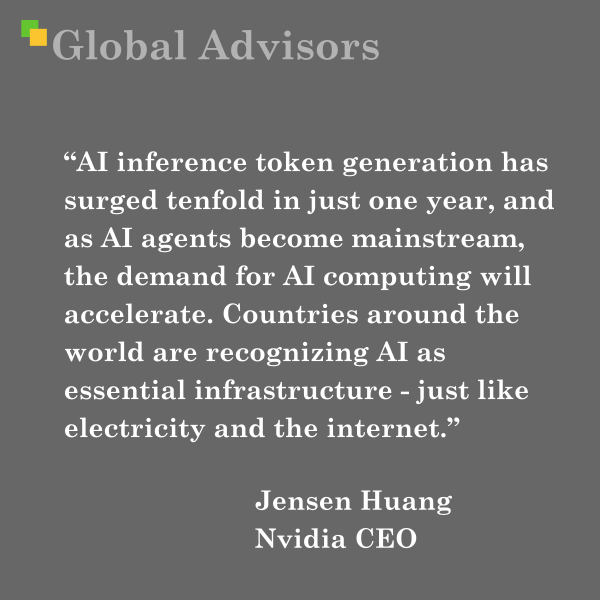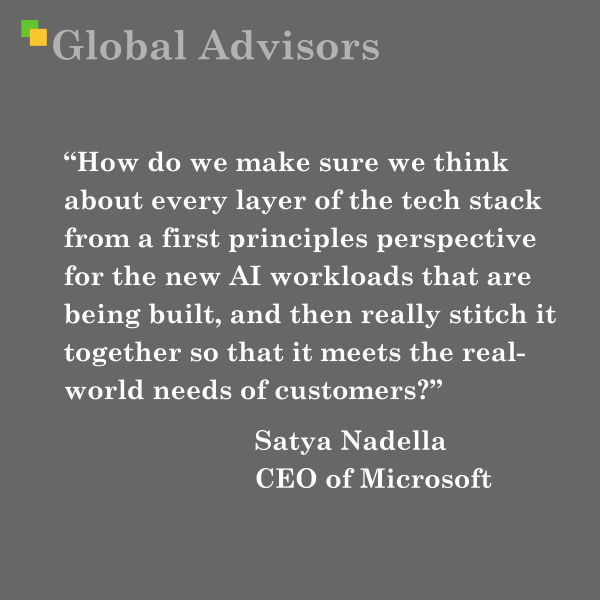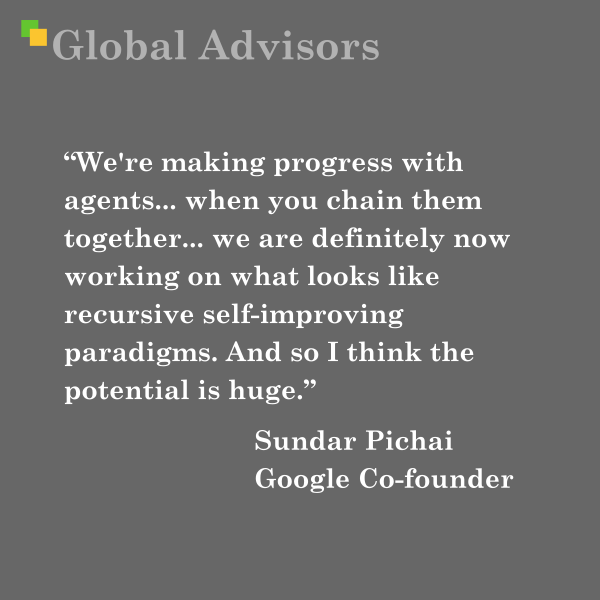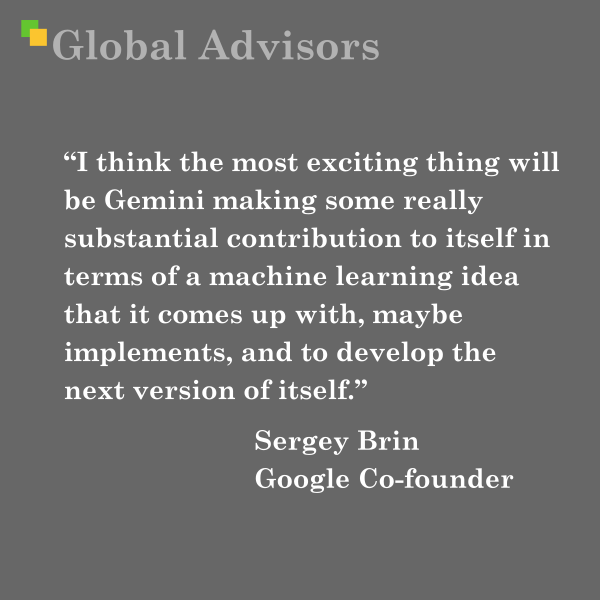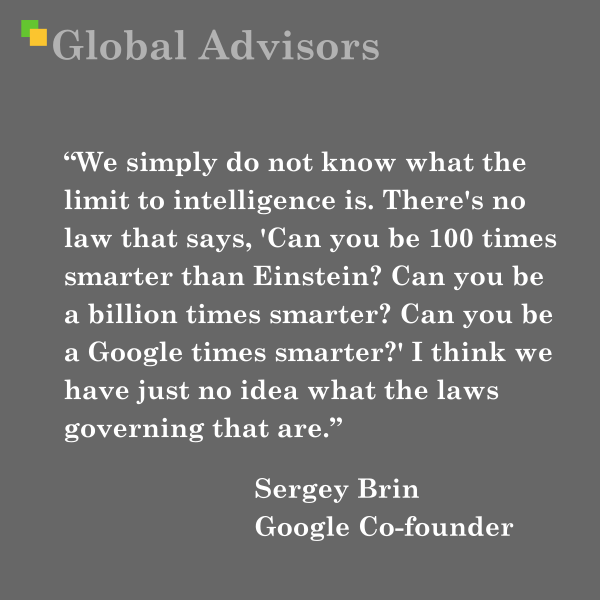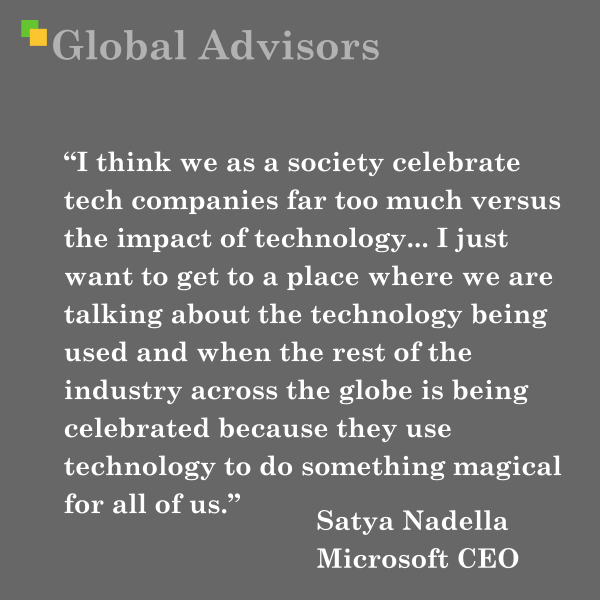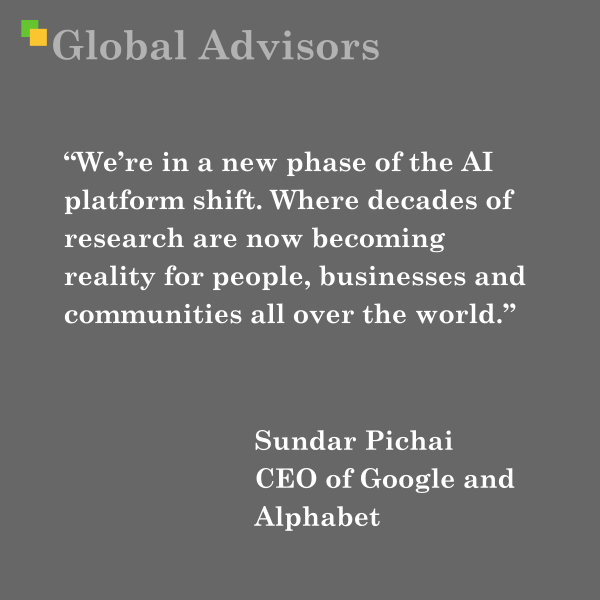| |
|
| |
| |
| |
|
Our selection of the top business news sources on the web. |
| |
| |
| |
Quote: Satya Nadella, Chairman and CEO of Microsoft“Somebody said to me once, ... 'You don't get fit by watching others go to the gym. You have to go to the gym.'” - Satya Nadella, the Chairman and CEO of MicrosoftThe quote—“Somebody said to me once, ... 'You don't get fit by watching others go to the gym. You have to go to the gym.'” — comes from an interview conducted immediately after Microsoft Build 2025, a flagship event that showcased the company’s vision for the agentic web and the next era of AI-powered productivity. Nadella used this metaphor to underscore a central pillar of his leadership philosophy: the necessity of hands-on engagement and personal transformation, rather than passive observation or reliance on case studies. In the interview, Nadella reflected on how, during times of rapid technological change, the only way for organizations—and individuals—to adapt is through direct, committed participation. He emphasized that no amount of studying the successes of others can substitute for real-world experimentation, learning, and iteration. For Nadella, this approach is critical not only for businesses grappling with disruptive technologies, but also for professionals seeking to remain resilient and relevant. Satya Nadella, Chairman and CEO of Microsoft, has long been recognized as the architect of Microsoft's modern resurgence. Born in Hyderabad, India, in 1967, Nadella’s formative years combined a love for cricket with an early fascination for technology. He pursued electrical engineering in India before moving to the United States for graduate studies, laying the technical and managerial foundation that would define his career. Joining Microsoft in 1992, Nadella rapidly advanced through various engineering and leadership roles. Early in his tenure, he played a key role in the development of Windows NT, setting the stage for his future focus on enterprise solutions. By the early 2010s, he had taken the helm of Microsoft’s cloud and enterprise initiatives, leading the creation and growth of Microsoft Azure—a service that would become a cornerstone of the company and one of the largest cloud platforms globally. When he was appointed CEO in 2014, Microsoft faced a period of stagnation, with mounting internal competition, disappointing product launches, and declining morale. Nadella initiated a deliberate shift, championing a "cloud-first, mobile-first" strategy and transforming the company's culture to prioritize collaboration, empathy, and a growth mindset. This new approach reinvigorated Microsoft, producing a decade of unprecedented innovation, market success, and making the company once again one of the world’s most valuable enterprises. Announcements at Microsoft Build 2025The Microsoft Build 2025 event marked a pivotal moment in the company’s AI strategy. Key announcements included:
These announcements illustrate the forward-leaning trajectory Nadella has set for Microsoft, blending technical prowess with an ethos of adaptability and continuous reinvention. His quote, situated in this context, is a rallying call: the future belongs to those willing to step into the arena, learn by doing, and transform alongside the technology they seek to harness.
|
| |
| |
Quote: Sholto Douglas, Anthropic researcher“We believe coding is extremely important because coding is that first step in which you will see AI research itself being accelerated... We think it is the most important leading indicator of model capabilities.” Sholto Douglas, Anthropic researcher Sholto Douglas is regarded as one of the most promising new minds in artificial intelligence research. Having graduated from the University of Sydney with a degree in Mechatronic (Space) Engineering under the guidance of Ian Manchester and Stefan Williams, Douglas entered the field of AI less than two years ago, quickly earning respect for his innovative contributions. At Anthropic, one of the leading AI research labs, he specializes in scaling reinforcement learning (RL) techniques within advanced language models, focusing on pushing the boundaries of what large language models can learn and execute autonomously. Context of the QuoteThe quote, delivered by Douglas in an interview with Redpoint—a venture capital firm known for its focus on disruptive startups and technology—underscores the central thesis driving Anthropic’s recent research efforts:
This statement reflects both the technical philosophy and the strategic direction of Anthropic’s latest research. Douglas views coding not only as a pragmatic benchmark but as a foundational skill that unlocks model self-improvement and, by extension, accelerates progress toward artificial general intelligence (AGI). Claude 4 Launch: Announcements and ImpactDouglas’ remarks came just ahead of the public unveiling of Anthropic’s Claude 4, the company’s most sophisticated model to date. The event highlighted several technical milestones:
Why This Moment MattersDouglas’ focus on coding as a metric is rooted in the idea that tasks requiring deep logic and creative problem-solving, such as programming, provide a "canary in the coal mine" for model sophistication. Success in these domains demonstrates a leap not only in computational power or data processing, but in the ability of AI models to autonomously reason, plan, and build tools that further accelerate their own learning cycles. The Claude 4 launch, and Douglas’ role within it, marks a critical inflection point in AI research. The ability of language models to code at—or beyond—expert human levels signals the arrival of AI systems capable of iteratively improving themselves, raising both hopes for extraordinary breakthroughs and urgent questions around safety, alignment, and governance. Sholto Douglas’ InfluenceThough relatively new to the field, Douglas has emerged as a thought leader shaping Anthropic’s approach to scalable, interpretable, and safe AI. His insights bridge technical expertise and strategic foresight, providing a clear-eyed perspective on the trajectory of rapidly advancing language models and their potential to fundamentally reshape the future of research and innovation.
|
| |
| |
Quote: Jensen Huang, Nvidia CEO“AI inference token generation has surged tenfold in just one year, and as AI agents become mainstream, the demand for AI computing will accelerate. Countries around the world are recognizing AI as essential infrastructure - just like electricity and the internet.” Jensen Huang, Nvidia CEO Context: The Nvidia 2026 Q1 resultsOn May 28, 2025, NVIDIA announced its financial results for the first quarter of fiscal year 2026, reporting a record-breaking revenue of $44,1 billion, a 69% increase from the previous year. This surge was primarily driven by robust demand for AI chips, with the data center segment contributing significantly, achieving a 73% year-over-year revenue increase to $39,1 billion. Despite these impressive figures, NVIDIA faced challenges due to U.S. export restrictions on its H20 chips to China, resulting in a $4,5 billion charge for excess inventory and an anticipated $8 billion revenue loss in the second quarter. During the earnings call, Huang criticized these restrictions, stating they have inadvertently spurred innovation in China rather than curbing it. In the context of these developments, Huang remarked, "AI inference token generation has surged tenfold in just one year, and as AI agents become mainstream, the demand for AI computing will accelerate. Countries around the world are recognizing AI as essential infrastructure—just like electricity and the internet." This statement underscores the transformative impact of AI across various sectors and highlights the critical role of AI infrastructure in modern economies. Under Huang's leadership, NVIDIA has not only achieved remarkable financial success but has also been at the forefront of AI and computing innovations. His strategic vision continues to shape the company's trajectory, navigating complex international dynamics while driving technological progress. Jensen Huang: Visionary Leader Behind NvidiaEarly Life and Education Jensen Huang, born in Tainan, Taiwan, in 1963, immigrated to the United States at a young age. He pursued his undergraduate studies in electrical engineering at Oregon State University, earning a Bachelor of Science degree, and later completed a Master of Science in Electrical Engineering at Stanford University. Before founding Nvidia, Huang gained industry experience at LSI Logic and Advanced Micro Devices (AMD), building a foundation in semiconductor technology and business leadership. Founding Nvidia and Early Struggles In 1993, at the age of 30, Huang co-founded Nvidia with Chris Malachowsky and Curtis Priem. The company’s inception was humble—its first meetings took place in a local Denny’s restaurant. The early years were marked by intense challenges and uncertainty. Nvidia’s initial focus on graphics accelerator chips nearly led to its demise, with the company surviving on a critical $5 million investment from Sega. By 1997, Nvidia was just a month away from running out of payroll funds before the release of the RIVA 128 chip turned its fortunes around. Huang’s leadership style was forged in these difficult times. He often reminded his team, “Our company is thirty days from going out of business,” a mantra that underscored the urgency and resilience required to survive in Silicon Valley’s fast-paced environment. Huang has credited these hardships as essential to his growth as a leader and to Nvidia’s eventual success. Transforming the Tech Landscape Under Huang’s stewardship, Nvidia pioneered the invention of the Graphics Processing Unit (GPU) in 1999, revolutionizing computer graphics and catalyzing the growth of the PC gaming industry. More recently, Nvidia has become a central player in the rise of artificial intelligence (AI) and accelerated computing, with its hardware and software platforms powering breakthroughs in data centers, autonomous vehicles, and generative AI. Huang’s vision and execution have earned him widespread recognition, including election to the National Academy of Engineering, the Semiconductor Industry Association’s Robert N. Noyce Award, the IEEE Founder’s Medal, and inclusion in TIME magazine’s list of the 100 most influential people.
|
| |
| |
Quote: Jensen Huang, Nvidia CEO“The question is not whether China will have AI, it already does.” Jensen Huang, Nvidia CEO Context: The Nvidia 2026 Q1 resultsOn May 28, 2025, NVIDIA announced its financial results for the first quarter of fiscal year 2026, reporting a record-breaking revenue of $44,1 billion, a 69% increase from the previous year. This surge was primarily driven by robust demand for AI chips, with the data center segment contributing significantly, achieving a 73% year-over-year revenue increase to $39,1 billion. Despite these impressive figures, NVIDIA faced challenges due to U.S. export restrictions on its H20 chips to China, resulting in a $4,5 billion charge for excess inventory and an anticipated $8 billion revenue loss in the second quarter. During the earnings call, Huang criticized these restrictions, stating they have inadvertently spurred innovation in China rather than curbing it. Huang's statement, "The question is not whether China will have AI, it already does," underscores his perspective on the global AI landscape. He emphasized that export controls may not prevent technological advancements in China but could instead accelerate domestic innovation. This viewpoint reflects Huang's broader understanding of the interconnectedness of global technology development and the challenges posed by geopolitical tensions. He followed by stating, "The question is whether one of the world's largest AI markets will run on American platforms. Shielding Chinese chipmakers from U.S. competition only strengthens them abroad and weakens America's position." Under Huang's leadership, NVIDIA has not only achieved remarkable financial success but has also been at the forefront of AI and computing innovations. His strategic vision continues to shape the company's trajectory, navigating complex international dynamics while driving technological progress. Jensen Huang: Visionary Leader Behind NvidiaEarly Life and Education Jensen Huang, born in Tainan, Taiwan, in 1963, immigrated to the United States at a young age. He pursued his undergraduate studies in electrical engineering at Oregon State University, earning a Bachelor of Science degree, and later completed a Master of Science in Electrical Engineering at Stanford University. Before founding Nvidia, Huang gained industry experience at LSI Logic and Advanced Micro Devices (AMD), building a foundation in semiconductor technology and business leadership. Founding Nvidia and Early Struggles In 1993, at the age of 30, Huang co-founded Nvidia with Chris Malachowsky and Curtis Priem. The company’s inception was humble—its first meetings took place in a local Denny’s restaurant. The early years were marked by intense challenges and uncertainty. Nvidia’s initial focus on graphics accelerator chips nearly led to its demise, with the company surviving on a critical $5 million investment from Sega. By 1997, Nvidia was just a month away from running out of payroll funds before the release of the RIVA 128 chip turned its fortunes around. Huang’s leadership style was forged in these difficult times. He often reminded his team, “Our company is thirty days from going out of business,” a mantra that underscored the urgency and resilience required to survive in Silicon Valley’s fast-paced environment. Huang has credited these hardships as essential to his growth as a leader and to Nvidia’s eventual success. Transforming the Tech Landscape Under Huang’s stewardship, Nvidia pioneered the invention of the Graphics Processing Unit (GPU) in 1999, revolutionizing computer graphics and catalyzing the growth of the PC gaming industry. More recently, Nvidia has become a central player in the rise of artificial intelligence (AI) and accelerated computing, with its hardware and software platforms powering breakthroughs in data centers, autonomous vehicles, and generative AI. Huang’s vision and execution have earned him widespread recognition, including election to the National Academy of Engineering, the Semiconductor Industry Association’s Robert N. Noyce Award, the IEEE Founder’s Medal, and inclusion in TIME magazine’s list of the 100 most influential people.
|
| |
| |
Quote: Satya Nadella, Chairman and CEO of Microsoft“How do we make sure we think about every layer of the tech stack from a first principles perspective for the new AI workloads that are being built, and then really stitch it together so that it meets the real-world needs of customers?” - Satya Nadella, the Chairman and CEO of MicrosoftThe quote is from Satya Nadella, Microsoft CEO in an interview with Matthew Berman. The interview took place immediately after Microsoft Build 2025. Satya Nadella, the Chairman and CEO of Microsoft, has been at the helm of the company since 2014, steering it through significant technological transformations. Under his leadership, Microsoft has embraced cloud computing, artificial intelligence (AI), and a more open-source approach, solidifying its position as a leader in the tech industry. The quote in question was delivered during an interview with Rowan Cheung immediately following the Microsoft Build 2025 conference. Microsoft Build is an annual event that showcases the company's latest innovations and developments, particularly in the realms of software development and cloud computing. Microsoft Build 2025: Key Announcements and Context At Microsoft Build 2025, held in Seattle, Microsoft underscored its deep commitment to artificial intelligence, with CEO Satya Nadella leading the event with a keynote emphasizing AI integration across Microsoft platforms. A significant highlight was the expansion of Copilot AI in Windows 11 and Microsoft 365, introducing features like autonomous agents and semantic search. Microsoft also showcased new Surface devices and introduced its own AI models to reduce reliance on OpenAI. In a strategic move, Microsoft announced it would host Elon Musk's xAI model, Grok, on its cloud platform, adding Grok 3 and Grok 3 mini to the portfolio of third-party AI models available through Microsoft’s cloud services. Additionally, Microsoft introduced NLWeb, an open project aimed at simplifying the development of AI-powered natural language web interfaces, and emphasized a vision of an “open agentic web,” where AI agents can perform tasks and make decisions for users and organizations. These announcements reflect Microsoft's strategic focus on AI and its commitment to providing developers with the tools and platforms necessary to build innovative, AI-driven applications.
|
| |
| |
Quote: Sundar Pichai - CEO of Google and Alphabet“We're making progress with agents... when you chain them together... we are definitely now working on what looks like recursive self-improving paradigms. And so I think the potential is huge.” - Sundar Pichai - CEO of Google and AlphabetAt the Google I/O 2025 conference, CEO Sundar Pichai unveiled a series of groundbreaking advancements that underscore Google's commitment to integrating artificial intelligence (AI) across its product ecosystem. In a post-event interview with Matthew Berman, Pichai highlighted the company's progress in developing AI agents capable of self-improvement, stating, "We're making progress with agents... when you chain them together... we are definitely now working on what looks like recursive self-improving paradigms. And so I think the potential is huge." This statement reflects Google's strategic focus on creating AI systems that not only perform complex tasks but also enhance their own capabilities over time. The concept of recursive self-improvement involves AI agents that can iteratively refine their algorithms and performance, leading to more efficient and intelligent systems. A prime example of this initiative is AlphaEvolve, an AI-powered evolutionary coding agent developed by Google DeepMind and unveiled in May 2025. AlphaEvolve is designed to autonomously discover and refine algorithms through a combination of large language models (LLMs) and evolutionary computation. Unlike domain-specific predecessors like AlphaFold or AlphaTensor, AlphaEvolve is a general-purpose system capable of operating across a wide array of scientific and engineering tasks by automatically modifying code and optimizing for multiple objectives. Its architecture allows it to evaluate code programmatically, reducing reliance on human input and mitigating risks such as hallucinations common in standard LLM outputs. During the conference, several key announcements illustrated this direction:
Pichai's emphasis on recursive self-improvement aligns with these developments, highlighting Google's ambition to create AI systems that not only perform tasks but also learn and evolve autonomously. This approach has the potential to revolutionize various industries by introducing AI solutions that continuously adapt and enhance their performance. The announcements at Google I/O 2025 reflect a broader trend in the tech industry toward more sophisticated and self-sufficient AI systems. By focusing on recursive self-improvement, Google is positioning itself at the forefront of this movement, aiming to deliver AI technologies that offer unprecedented levels of efficiency and intelligence. Sundar Pichai: From Chennai to Silicon ValleyEarly Life and Academic FoundationsBorn in Madurai, Tamil Nadu, in 1972, Pichai Sundararajan grew up in a middle-class household in Chennai. His father, Regunatha Pichai, worked as an electrical engineer at General Electric Company (GEC), while his mother, Lakshmi, was a stenographer before becoming a homemaker. The family lived in a modest two-room apartment, where Pichai’s curiosity about technology was nurtured by his father’s discussions about engineering and his mother’s emphasis on education. Pichai attended Jawahar Vidyalaya and later Vana Vani Matriculation Higher Secondary School, where his academic prowess and fascination with electronics became evident. Classmates recall his ability to memorize phone numbers effortlessly and his habit of disassembling household gadgets to understand their mechanics. These early experiences laid the groundwork for his technical mindset. After excelling in his Class XII exams, Pichai earned admission to the Indian Institute of Technology (IIT) Kharagpur, where he studied metallurgical engineering. Despite the unconventional choice of discipline, he graduated at the top of his class, earning a Silver Medal for academic excellence. His professors, recognizing his potential, encouraged him to pursue graduate studies abroad. Pichai subsequently earned a Master’s degree in materials science from Stanford University and an MBA from the Wharton School of the University of Pennsylvania, where he was named a Siebel Scholar and Palmer Scholar. Career at Google: Architect of the Modern WebPichai joined Google in 2004, a pivotal year marked by the launch of Gmail. His early contributions included leading the development of the Google Toolbar and Chrome browser, which emerged as critical tools in countering Microsoft’s dominance with Internet Explorer. Pichai’s strategic foresight was evident in his advocacy for ChromeOS, unveiled in 2009, and the Chromebook, which redefined affordable computing. By 2013, Pichai’s responsibilities expanded to include Android, Google’s mobile operating system. Under his leadership, Android grew to power over 3 billion devices globally, while initiatives like Google Drive, Maps, and Workspace became ubiquitous productivity tools. His ascent continued in 2015 when he was named CEO of Google, and later, in 2019, CEO of Alphabet, overseeing a portfolio spanning AI, healthcare, and autonomous technologies. The AI Platform Shift: Context of the 2025 KeynoteFrom Research to RealityPichai’s quote at Google I/O 2025 reflects a strategic inflection point. For years, Google’s AI advancements—from DeepMind’s AlphaGo to the Transformer architecture—existed primarily in research papers and controlled demos. The 2025 keynote, however, emphasized operationalizing AI at scale, transforming theoretical breakthroughs into tools that reshape industries and daily life. Key Announcements at Google I/O 2025The event showcased over 20 AI-driven innovations, anchored by several landmark releases: 1. Gemini 2.5 Pro and Flash: The Intelligence EngineGoogle’s flagship AI model, Gemini 2.5 Pro, introduced Deep Think—a reasoning framework that evaluates multiple hypotheses before generating responses. Benchmarks showed a 40% improvement in solving complex mathematical and coding problems compared to previous models. Meanwhile, Gemini 2.5 Flash optimized efficiency, reducing token usage by 30% while maintaining accuracy, enabling cost-effective deployment in customer service and logistics. 2. TPU Ironwood: Powering the AI InfrastructureThe seventh-generation Tensor Processing Unit (TPU), codenamed Ironwood, delivered a 10x performance leap over its predecessor. With 42.5 exaflops per pod, Ironwood became the backbone for training and inferencing Gemini models, reducing latency in applications like real-time speech translation and 3D rendering. 3. Google Beam: Redefining Human ConnectionEvolving from Project Starline, Google Beam combined AI with lightfield displays to create immersive 3D video calls. Using six cameras and a neural video model, Beam rendered participants in real-time with millimeter-precise head tracking, aiming to eliminate the “flatness” of traditional video conferencing. 4. Veo 3 and Flow: Democratizing CreativityVeo 3, Google’s advanced video generation model, enabled filmmakers to produce high-fidelity scenes using natural language prompts. Paired with Flow—a collaborative AI filmmaking suite—the tools allowed creators to edit footage, generate CGI, and score soundtracks through multimodal inputs. 5. AI Mode for Search: The Next-Generation Query EngineExpanding on 2024’s AI Overviews, AI Mode reimagined search as a dynamic, multi-step reasoning process. By fanning out queries across specialized sub-models, it provided nuanced answers to complex questions like “Plan a sustainable wedding under $5,000” or “Compare immunotherapy options for Stage 3 melanoma”. 6. Project Astra: Toward a Universal AI AssistantIn a preview of future ambitions, Project Astra demonstrated an AI agent capable of understanding real-world contexts through smartphone cameras. It could troubleshoot broken appliances, analyze lab results, or navigate public transit systems—hinting at a future where AI serves as an omnipresent collaborator. The Significance of the “AI Platform Shift”A Convergence of CapabilitiesPichai’s declaration underscores how Google’s investments in AI infrastructure, models, and applications have reached critical mass. The integration of Gemini into products like Workspace, Android, and Cloud—coupled with hardware like TPU Ironwood—creates a flywheel effect: better models attract more users, whose interactions refine the models further. Ethical and Economic ImplicationsWhile celebrating progress, Pichai acknowledged challenges. The shift toward agentic AI—systems that “take action” autonomously—raises questions about privacy, bias, and job displacement. Google’s partnership with the Institut Curie for AI-driven cancer detection and wildfire prediction tools exemplify efforts to align AI with societal benefit. Economically, the $75 billion invested in AI data centers signals Google’s commitment to leading the global race, though concerns about energy consumption and market consolidation persist. Conclusion: Leadership in the Age of AISundar Pichai’s journey—from a Chennai classroom to steering Alphabet’s AI ambitions—mirrors the trajectory of modern computing. His emphasis on making AI “helpful for everyone” reflects a philosophy rooted in accessibility and utility, principles evident in Google’s 2025 releases. As decades of research materialize into tools like Gemini and Beam, the challenge lies in ensuring these technologies empower rather than exclude—a mission that will define Pichai’s legacy and the next chapter of the AI era. The Google I/O 2025 keynote did not merely showcase new products; it marked the culmination of a vision Pichai has championed since his early days at Google: technology that disappears into the fabric of daily life, enhancing human potential without demanding attention. In this new phase of the platform shift, that vision is closer than ever to reality.
|
| |
| |
Quote: Sergey Brin, Google Co-founder“I think the most exciting thing will be Gemini making some really substantial contribution to itself in terms of a machine learning idea that it comes up with, maybe implements, and to develop the next version of itself.” - Sergey Brin, Google Co-founderThe quote is from Sergey Brin, Google Co-founder in an interview with CatGPT. The interview took place immediately after Google IO 2025. Sergey Brin, born on August 21, 1973, in Moscow, Russia, is a renowned computer scientist and entrepreneur best known for co-founding Google alongside Larry Page. His journey from a young immigrant to a tech visionary has significantly influenced the digital landscape. Early Life and Education In 1979, at the age of six, Brin's family emigrated from the Soviet Union to the United States, seeking greater opportunities and freedom. They settled in Maryland, where Brin developed an early interest in mathematics and computer science, inspired by his father, a mathematics professor. He pursued his undergraduate studies at the University of Maryland, earning a Bachelor of Science in Computer Science and Mathematics in 1993. Brin then continued his education at Stanford University, where he met Larry Page, setting the stage for their future collaboration. The Genesis of Google While at Stanford, Brin and Page recognized the limitations of existing search engines, which ranked results based on the number of times a search term appeared on a page. They developed the PageRank algorithm, which assessed the importance of web pages based on the number and quality of links to them. This innovative approach led to the creation of Google in 1998, a name derived from "googol," reflecting their mission to organize vast amounts of information. Google's rapid growth revolutionized the way people accessed information online. Leadership at Google As Google's President of Technology, Brin played a pivotal role in the company's expansion and technological advancements. Under his leadership, Google introduced a range of products and services, including Gmail, Google Maps, and Android. In 2015, Google underwent a significant restructuring, becoming a subsidiary of Alphabet Inc., with Brin serving as its president. He stepped down from this role in December 2019 but remained involved as a board member and controlling shareholder. Advancements in Artificial Intelligence In May 2025, during the Google I/O conference, Brin participated in an interview where he discussed the rapid advancements in artificial intelligence (AI). He highlighted the unpredictability of AI's potential, stating, "We simply do not know what the limit to intelligence is. There's no law that says, 'Can you be 100 times smarter than Einstein? Can you be a billion times smarter? Can you be a Google times smarter?' I think we have just no idea what the laws governing that are." At the same event, Google unveiled significant updates to its Gemini AI models. The Gemini 2.5 Pro model introduced the "Deep Think" mode, enhancing the AI's ability to tackle complex tasks, including advanced reasoning and coding. Additionally, the Gemini 2.5 Flash model became the default, offering faster response times. These developments underscore Google's commitment to integrating advanced AI technologies into its services, aiming to provide users with more intuitive and efficient experiences. Personal Life and Legacy Beyond his professional achievements, Brin has been involved in various philanthropic endeavors, particularly in supporting research for Parkinson's disease, a condition affecting his mother. His personal and professional journey continues to inspire innovation and exploration in the tech industry. Brin's insights into the future of AI reflect a broader industry perspective on the transformative potential of artificial intelligence. His contributions have not only shaped Google's trajectory but have also had a lasting impact on the technological landscape.
|
| |
| |
Quote: Sergey Brin, Google Co-founder“We simply do not know what the limit to intelligence is. There's no law that says, 'Can you be 100 times smarter than Einstein? Can you be a billion times smarter? Can you be a Google times smarter?' I think we have just no idea what the laws governing that are.” - Sergey Brin, Google Co-founderThe quote is from Sergey Brin, Google Co-founder in an interview with CatGPT. The interview took place immediately after Google IO 2025. Sergey Brin, born on August 21, 1973, in Moscow, Russia, is a renowned computer scientist and entrepreneur best known for co-founding Google alongside Larry Page. His journey from a young immigrant to a tech visionary has significantly influenced the digital landscape. Early Life and Education In 1979, at the age of six, Brin's family emigrated from the Soviet Union to the United States, seeking greater opportunities and freedom. They settled in Maryland, where Brin developed an early interest in mathematics and computer science, inspired by his father, a mathematics professor. He pursued his undergraduate studies at the University of Maryland, earning a Bachelor of Science in Computer Science and Mathematics in 1993. Brin then continued his education at Stanford University, where he met Larry Page, setting the stage for their future collaboration. The Genesis of Google While at Stanford, Brin and Page recognized the limitations of existing search engines, which ranked results based on the number of times a search term appeared on a page. They developed the PageRank algorithm, which assessed the importance of web pages based on the number and quality of links to them. This innovative approach led to the creation of Google in 1998, a name derived from "googol," reflecting their mission to organize vast amounts of information. Google's rapid growth revolutionized the way people accessed information online. Leadership at Google As Google's President of Technology, Brin played a pivotal role in the company's expansion and technological advancements. Under his leadership, Google introduced a range of products and services, including Gmail, Google Maps, and Android. In 2015, Google underwent a significant restructuring, becoming a subsidiary of Alphabet Inc., with Brin serving as its president. He stepped down from this role in December 2019 but remained involved as a board member and controlling shareholder. Advancements in Artificial Intelligence In May 2025, during the Google I/O conference, Brin participated in an interview where he discussed the rapid advancements in artificial intelligence (AI). He highlighted the unpredictability of AI's potential, stating, "We simply do not know what the limit to intelligence is. There's no law that says, 'Can you be 100 times smarter than Einstein? Can you be a billion times smarter? Can you be a Google times smarter?' I think we have just no idea what the laws governing that are." At the same event, Google unveiled significant updates to its Gemini AI models. The Gemini 2.5 Pro model introduced the "Deep Think" mode, enhancing the AI's ability to tackle complex tasks, including advanced reasoning and coding. Additionally, the Gemini 2.5 Flash model became the default, offering faster response times. These developments underscore Google's commitment to integrating advanced AI technologies into its services, aiming to provide users with more intuitive and efficient experiences. Personal Life and Legacy Beyond his professional achievements, Brin has been involved in various philanthropic endeavors, particularly in supporting research for Parkinson's disease, a condition affecting his mother. His personal and professional journey continues to inspire innovation and exploration in the tech industry. Brin's insights into the future of AI reflect a broader industry perspective on the transformative potential of artificial intelligence. His contributions have not only shaped Google's trajectory but have also had a lasting impact on the technological landscape.
|
| |
| |
Quote: Satya Nadella, Chairman and CEO of Microsoft“I think we as a society celebrate tech companies far too much versus the impact of technology... I just want to get to a place where we are talking about the technology being used and when the rest of the industry across the globe is being celebrated because they use technology to do something magical for all of us, that would be the day.” - Satya Nadella, the Chairman and CEO of MicrosoftThe quote is from Satya Nadella, Microsoft CEO in an interview with Rowan Cheung. The interview took place immediately after Microsoft Build 2025. Satya Nadella, the Chairman and CEO of Microsoft, has been at the helm of the company since 2014, steering it through significant technological transformations. Under his leadership, Microsoft has embraced cloud computing, artificial intelligence (AI), and a more open-source approach, solidifying its position as a leader in the tech industry. The quote in question was delivered during an interview with Rowan Cheung immediately following the Microsoft Build 2025 conference. Microsoft Build is an annual event that showcases the company's latest innovations and developments, particularly in the realms of software development and cloud computing. Microsoft Build 2025: Key Announcements and Context At Microsoft Build 2025, held in Seattle, Microsoft underscored its deep commitment to artificial intelligence, with CEO Satya Nadella leading the event with a keynote emphasizing AI integration across Microsoft platforms. A significant highlight was the expansion of Copilot AI in Windows 11 and Microsoft 365, introducing features like autonomous agents and semantic search. Microsoft also showcased new Surface devices and introduced its own AI models to reduce reliance on OpenAI. In a strategic move, Microsoft announced it would host Elon Musk's xAI model, Grok, on its cloud platform, adding Grok 3 and Grok 3 mini to the portfolio of third-party AI models available through Microsoft’s cloud services. Additionally, Microsoft introduced NLWeb, an open project aimed at simplifying the development of AI-powered natural language web interfaces, and emphasized a vision of an “open agentic web,” where AI agents can perform tasks and make decisions for users and organizations. These announcements reflect Microsoft's strategic focus on AI and its commitment to providing developers with the tools and platforms necessary to build innovative, AI-driven applications.
|
| |
| |
Quote: Sundar Pichai - CEO of Google and Alphabet“We’re in a new phase of the AI platform shift. Where decades of research are now becoming reality for people, businesses and communities all over the world.” - Sundar Pichai - CEO of Google and AlphabetIn a defining moment at Google I/O 2025, Sundar Pichai, CEO of Google and Alphabet, articulated a transformative vision: “We’re in a new phase of the AI platform shift. Where decades of research are now becoming reality for people, businesses, and communities all over the world.” This statement, delivered during his keynote address, encapsulates both Google’s trajectory under Pichai’s leadership and the seismic technological advancements unveiled at the event. To fully grasp the significance of this declaration, one must examine Pichai’s journey, the strategic context of Google’s AI evolution, and the groundbreaking tools announced at I/O 2025. Sundar Pichai: From Chennai to Silicon ValleyEarly Life and Academic FoundationsBorn in Madurai, Tamil Nadu, in 1972, Pichai Sundararajan grew up in a middle-class household in Chennai. His father, Regunatha Pichai, worked as an electrical engineer at General Electric Company (GEC), while his mother, Lakshmi, was a stenographer before becoming a homemaker. The family lived in a modest two-room apartment, where Pichai’s curiosity about technology was nurtured by his father’s discussions about engineering and his mother’s emphasis on education. Pichai attended Jawahar Vidyalaya and later Vana Vani Matriculation Higher Secondary School, where his academic prowess and fascination with electronics became evident. Classmates recall his ability to memorize phone numbers effortlessly and his habit of disassembling household gadgets to understand their mechanics. These early experiences laid the groundwork for his technical mindset. After excelling in his Class XII exams, Pichai earned admission to the Indian Institute of Technology (IIT) Kharagpur, where he studied metallurgical engineering. Despite the unconventional choice of discipline, he graduated at the top of his class, earning a Silver Medal for academic excellence. His professors, recognizing his potential, encouraged him to pursue graduate studies abroad. Pichai subsequently earned a Master’s degree in materials science from Stanford University and an MBA from the Wharton School of the University of Pennsylvania, where he was named a Siebel Scholar and Palmer Scholar. Career at Google: Architect of the Modern WebPichai joined Google in 2004, a pivotal year marked by the launch of Gmail. His early contributions included leading the development of the Google Toolbar and Chrome browser, which emerged as critical tools in countering Microsoft’s dominance with Internet Explorer. Pichai’s strategic foresight was evident in his advocacy for ChromeOS, unveiled in 2009, and the Chromebook, which redefined affordable computing. By 2013, Pichai’s responsibilities expanded to include Android, Google’s mobile operating system. Under his leadership, Android grew to power over 3 billion devices globally, while initiatives like Google Drive, Maps, and Workspace became ubiquitous productivity tools. His ascent continued in 2015 when he was named CEO of Google, and later, in 2019, CEO of Alphabet, overseeing a portfolio spanning AI, healthcare, and autonomous technologies. The AI Platform Shift: Context of the 2025 KeynoteFrom Research to RealityPichai’s quote at Google I/O 2025 reflects a strategic inflection point. For years, Google’s AI advancements—from DeepMind’s AlphaGo to the Transformer architecture—existed primarily in research papers and controlled demos. The 2025 keynote, however, emphasized operationalizing AI at scale, transforming theoretical breakthroughs into tools that reshape industries and daily life. Key Announcements at Google I/O 2025The event showcased over 20 AI-driven innovations, anchored by several landmark releases: 1. Gemini 2.5 Pro and Flash: The Intelligence EngineGoogle’s flagship AI model, Gemini 2.5 Pro, introduced Deep Think—a reasoning framework that evaluates multiple hypotheses before generating responses. Benchmarks showed a 40% improvement in solving complex mathematical and coding problems compared to previous models. Meanwhile, Gemini 2.5 Flash optimized efficiency, reducing token usage by 30% while maintaining accuracy, enabling cost-effective deployment in customer service and logistics. 2. TPU Ironwood: Powering the AI InfrastructureThe seventh-generation Tensor Processing Unit (TPU), codenamed Ironwood, delivered a 10x performance leap over its predecessor. With 42.5 exaflops per pod, Ironwood became the backbone for training and inferencing Gemini models, reducing latency in applications like real-time speech translation and 3D rendering. 3. Google Beam: Redefining Human ConnectionEvolving from Project Starline, Google Beam combined AI with lightfield displays to create immersive 3D video calls. Using six cameras and a neural video model, Beam rendered participants in real-time with millimeter-precise head tracking, aiming to eliminate the “flatness” of traditional video conferencing. 4. Veo 3 and Flow: Democratizing CreativityVeo 3, Google’s advanced video generation model, enabled filmmakers to produce high-fidelity scenes using natural language prompts. Paired with Flow—a collaborative AI filmmaking suite—the tools allowed creators to edit footage, generate CGI, and score soundtracks through multimodal inputs. 5. AI Mode for Search: The Next-Generation Query EngineExpanding on 2024’s AI Overviews, AI Mode reimagined search as a dynamic, multi-step reasoning process. By fanning out queries across specialized sub-models, it provided nuanced answers to complex questions like “Plan a sustainable wedding under $5,000” or “Compare immunotherapy options for Stage 3 melanoma”. 6. Project Astra: Toward a Universal AI AssistantIn a preview of future ambitions, Project Astra demonstrated an AI agent capable of understanding real-world contexts through smartphone cameras. It could troubleshoot broken appliances, analyze lab results, or navigate public transit systems—hinting at a future where AI serves as an omnipresent collaborator. The Significance of the “AI Platform Shift”A Convergence of CapabilitiesPichai’s declaration underscores how Google’s investments in AI infrastructure, models, and applications have reached critical mass. The integration of Gemini into products like Workspace, Android, and Cloud—coupled with hardware like TPU Ironwood—creates a flywheel effect: better models attract more users, whose interactions refine the models further. Ethical and Economic ImplicationsWhile celebrating progress, Pichai acknowledged challenges. The shift toward agentic AI—systems that “take action” autonomously—raises questions about privacy, bias, and job displacement. Google’s partnership with the Institut Curie for AI-driven cancer detection and wildfire prediction tools exemplify efforts to align AI with societal benefit. Economically, the $75 billion invested in AI data centers signals Google’s commitment to leading the global race, though concerns about energy consumption and market consolidation persist. Conclusion: Leadership in the Age of AISundar Pichai’s journey—from a Chennai classroom to steering Alphabet’s AI ambitions—mirrors the trajectory of modern computing. His emphasis on making AI “helpful for everyone” reflects a philosophy rooted in accessibility and utility, principles evident in Google’s 2025 releases. As decades of research materialize into tools like Gemini and Beam, the challenge lies in ensuring these technologies empower rather than exclude—a mission that will define Pichai’s legacy and the next chapter of the AI era. The Google I/O 2025 keynote did not merely showcase new products; it marked the culmination of a vision Pichai has championed since his early days at Google: technology that disappears into the fabric of daily life, enhancing human potential without demanding attention. In this new phase of the platform shift, that vision is closer than ever to reality.
|
| |
| |
|
| |
| |



